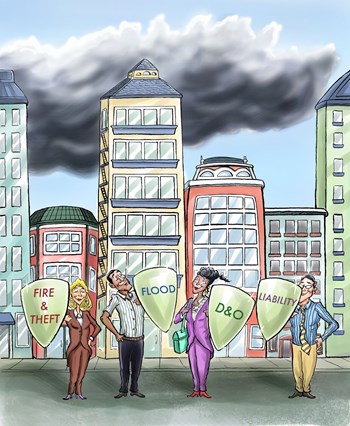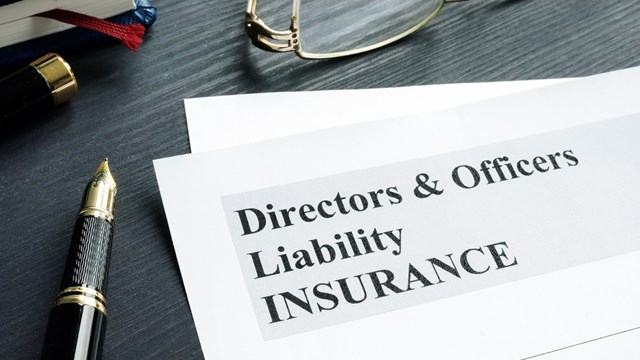
Good afternoon—and welcome to the board. Your mission should you choose to accept it is to make decisions to better your building. The residents may not like you and, more importantly, may not like those decisions. Nevertheless, keep doing the job you’re doing. In a worst-case scenario, you will be sued. Perhaps more than once. Should anything go wrong, don’t worry; you’re protected by the board's D&O insurance. Good luck.”
On-the-Job Protection
You volunteer to be on your co-op or condo association’s board. You do your best to help make the right decisions and make your HOA a great place to live. Unfortunately, one of your fellow residents doesn’t like a decision you made and takes you and the rest of the board to court. They are suing for thousands of dollars—maybe even millions. Your home, life savings and other assets are at risk if you lose.
With stakes like that, it would be virtually impossible for co-op and condo boards to find volunteers if there wasn't some form of protection from lawsuits resulting from the decisions made by board members in the course of doing their job. Fortunately, that protection exists, in the form of Directors and Officers insurance—D&O for short.
Some people think that it's only the board that initiates the lawsuits when homeowners are late with dues, or because they broke the rules, but lawsuits are a two-way street, says Kevin M. LaCroix, Esq., executive vice president of OakBridge Insurance Services, an Ohio-based insurer with clients in New Jersey and New York.
“They can be sued by members of the HOA and by third parties who provide services or goods to the association,” says LaCroix. “There’s no reason to serve on a board and face risk of potential liability without adequate coverage.”
Take a recent lawsuit profiled in The New York Times where the former president of a co-op board sued the board, claiming that racial discrimination was the reason the board did not let him buy a neighboring apartment. The board debated that the resident couldn’t afford both units. They went to court—and the legal fee meter started ticking overtime.
A few years ago, Moneymagazine profiled an ongoing legal battle in California where a homeowners association was suing a resident for taking too long to do their landscaping. The resident lobbied back with a countersuit.
In Michigan, a resident filed a lawsuit to against his condominium association to resolve a dispute over who should pay for a road repair in a condominium complex where he owns a unit. The resident wasn’t happy that the association was assessing the residents to pay almost $30,000 to repair an access road, which the resident said was a public road. The resident decided to sue the board and let a judge decide.
“People get emotionally excited about what you do as a board member,” says Kevin Davis, president of Kevin Davis Insurance in Los Angeles, California. “You tell them no you can’t have a pet, or hang your laundry on the balcony. The residents will say ‘Who are you to tell me that I can’t?’ It’s the number-one reason for lawsuits.”
Crash-Helmet Coverage
Think of D&O, or directors and officers, insurance, as your own personal protective helmet from fastball lawsuits. “It [provides] you with a lawyer to defend against claims if you get sued,” says David J. Byrne, a shareholder attorney with the Lawrenceville-based law firm of Stark & Stark, “but it doesn't protect anybody from criminal actions, such as fraud or self-dealing.”
“What it does cover, for the most part, are things like employment discrimination, architectural disputes, inadequate reserves, negligence, third-party breach of contract, arguments of reassessments, liens, defamation, basically various types of breach of fiduciary duty,” says Paul Felsen of Felsen Insurance Services, Inc. in Denville. “There are literally hundreds of actions that can be brought against a board member these days when people are unhappy. Every policy is different, and every policy has different exclusions. A typical exclusion would be any act that's deliberately dishonest or fraudulent, any willful violation of the statute or regulation.
“Normally, if an action is brought against the property manager, the manager is usually included under the D&O policy, but the coverage sometimes will fall under the property manager's professional liability coverage,” Felsen continues. “This is not a professional liability coverage for the property manager per se, or the property management company, [but it] includes the property manager as an additional insured, though the coverage is not broader than what that would be for the board itself.”
Fortunately, Davis says that in most lawsuits, “They are suing because they want a right to do something,” rather than for a big financial payout. “For example, an individual in Unit H on the second floor had a nice view, but now a tree is blocking it. He asks to have it cut down. The resident in the unit below him says no, it’s shading his apartment. In this case, the board didn’t uphold their fiduciary responsibility. If Unit H bought a view, they need to make sure they maintain the view, so they’ll go to court, just to see who’s right and who’s wrong.”
Whos & Whats
To find out if your board has a policy, just ask. However, don’t assume you’re automatically covered without taking a good look at the policy. Like fingerprints, every D&O policy is different.
“My personal opinion—and I would like to think that most insurance professionals agree with it—is when you see the coverage included in a package policy and you look at that premium and the premium comes out to $247 or something like that, you're really getting a plain vanilla coverage with lots of exclusions and not very, very broad coverage terms and definitions,” says Felsen. “We strongly recommend that directors coverage be written on a monoline, stand-alone policy through a company that specializes in D&O for community associations. The premium is going to be more, but the coverage is going to be much, much broader and you're going to be dealing with a company that's an expert in the field.”
When negotiating your D&O coverage, Byrne says “It's nice if you can try to get a 'consent to settle provision', which is that the D&O carrier doesn't have the right to settle a lawsuit without the board's consent. And I think they ought to try to get a provision by which they are allowed to choose their own lawyer, provided that the lawyer is willing to accept the rates that the insurance company charges or will pay.”
“I warn our associations to be careful when drafting policies,” says Jennifer Loheac, an attorney with Becker & Poliakoff in Morristown. “For example, governing documents include indemnity language for board members, and volunteers on committees would frequently fall under this coverage as well. However, that's not always clear. Associations should also be aware that if the association agrees to indemnify people, but the insurance coverage does not cover the defense or the action, the association may have to make up the difference. This is why I advise associations to try to be very clear on exactly what their D&O policy covers. To the extent the association intends to cover many volunteer committees, maybe consider actually naming those committees in the policy. Also, as tempting as it is for many communities to create specific policy resolutions promising indemnification, the bottom line is that if the insurance—for whatever reason—declines coverage or issues partial coverage, it's better that the association does not draft a lengthy policy resolution promising volunteers indemnity, defense, etc. because this can be relied upon by volunteers, and the association may end up footing the bill for very expensive, unanticipated actions where costs or scope exceed insurance coverage.”
There are exclusions to consider as well. “The myth is that D&O insurance covers everything, which obviously isn’t true,” says Adam S. Collins, CIC, and assistant vice president at Aon Affinity, Ian H. Graham Insurance in Sherman Oaks, California, which has multiple clients in the tri-state area. “Some of the more important exclusions contained in a D&O policy are damage or destruction to tangible property, bodily injury, construction defects, and intentional criminal acts.”
That last item is a very important one. Does D&O coverage protect the co-op, condo, or HOA from criminal actions by the director or officers? It seems a straightforward enough question but it can sometimes be surprisingly tough to answer.
“Most, if not all, D&O policies contain a provision that excludes intentional criminal and fraudulent acts committed by board members,” says Collins. “However, our policy will continue to defend the directors and/or officers until such time that a criminal action can be proven. The policy will then cease to provide any further protection once it is determined that a board member knowingly committed a criminal or fraudulent act.”
D&O coverage also doesn't indemnify a board or board member against decisions made "in bad faith," or with illegal intent. If a board is found to have acted in an illegal manner—deliberately discriminating against a prospective buyer, for example—and are hit with punitive damages, members are on their own when it comes to paying them.
What is the Cost?
A stand-alone policy typically starts at a minimum annual premium of around $1,200 and will increase depending on the number of units in the building and other factors. The co-op or condo is generally responsible for paying the premium for this specific type of coverage.
“Premiums can also be impacted by additional exposures—such as commercial tenants, to name one—and/or the number of employees,” says Collins.
According to Steve Reisler, vice president of TD Insurance, the coverage arm of TD Bank, “The cost of D&O coverage is usually based on the number of units in the association, and the association's loss history. An association can pay as little as $500 to as much as $10,000 annually for coverage, which is traditionally paid for out of the maintenance fees collected from the unit owners. There are several companies that provide D&O coverage for community associations. Some of them include Chubb, CNA, Chartis, Great American and Travelers. Most of the D&O is offered through managing general agents (MGA's) like McGowan, Distinguished Programs and Ian H. Graham. These MGA's specialize in providing insurance for Community associations.”
When it comes time to cutting a check, Collins says that not all D&O policies are created equal. “Most stand-alone policies contain a ‘Duty to Defend’ provision,” says Collins. “In other words, our D&O provides a defense for the board once they accept the claim. The obvious benefit is that the association doesn’t have to front the money (except for the retention) in hopes of having it reimbursed to them by the association or the insurance policy, as is the case with standard D&O policy or embedded form. The converse to that is an “indemnification” provision contained in some less comprehensive D&O forms.”
If your association doesn’t have or won’t get insurance, the Nonprofit Risk Management Center (NRMC), says that every state has a volunteer protection law and the federal Volunteer Protection Act (VPA) became effective in September of 2010. The Act provides that, if a volunteer meets certain criteria, he or she shall not be liable for simple negligence while acting on behalf of a nonprofit or governmental organization.
The VPA also provides limitations on the assessment of non-economic losses and punitive damages against a volunteer. The Volunteer Protection Act does not, however, protect a volunteer from liability for harm "caused by willful or criminal misconduct, gross negligence, reckless misconduct, or a conscious, flagrant indifference to the rights or safety of the individual harmed by the volunteer." The act does not prohibit lawsuits against volunteers nor does it provide any protection for nonprofits. Some of the notable stand-alone D&O programs that are specifically tailored to community associations are written with CNA, Travelers, Great American, Chubb and Chartis.
To reduce any potential expenses from D&O insurance, it’s best to have a board that is well informed of their responsibilities. “Know, understand and follow the bylaws and CC&R’s, educate all board members, and attend law seminars, risk management seminars specifically designed for community association boards,” advises Collins, who recommends both The New Jersey Cooperator and the national and the New Jersey chapters of Community Associations Institute (CAI-NJ) as viable resources for board member education.
It's tough enough to get people interested in taking positions on their co-op or condo board without the threat of lawsuit damages hanging over their heads. Board education and good communication are two pieces of protection against legal action; a solid D&O policy is third piece of the puzzle.
Lisa Iannucci is a freelance writer and author and a frequent contributor to The New Jersey Cooperator.






Leave a Comment